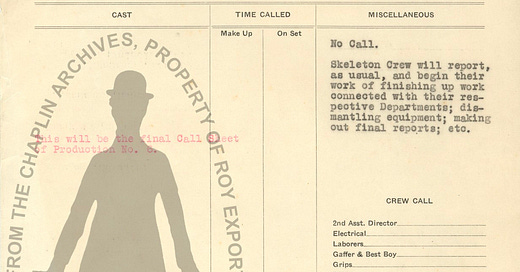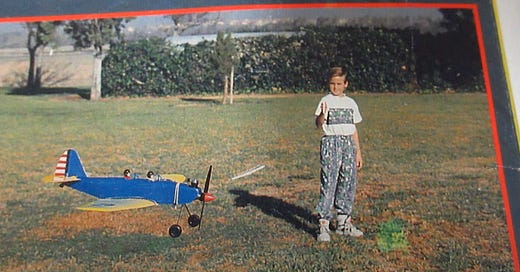
Matt Locke (ML) is a WITI reader and the Director of Storythings, a content studio in the UK. He previously wrote the Andy Warhol Album Covers Edition and the TV Schedule Edition.
Matt here. Making a film is a remarkable feat of coordination, craft, and luck. Especially if you are on location, there are multiple factors that will affect what you can shoot in a day, with many of them—like the weather and light levels—out of your control. So when you’re making a movie, you need a plan to control as many of these factors as possible. This is where the call sheet comes in.
The call sheet might look like a simple piece of paper, but it’s a miracle of organization and information—compressing the complex processes of movie making into a clear set of instructions that every single person involved can understand.
Unlike the status hierarchy of communication formats in most industries (like emails or memos with their carefully curated cc lists), the call sheet works because it’s democratic—everyone on set gets the same printout, regardless of whether you’re the A-list star or the person making the sandwiches. The call sheet has to work for everyone, as without it, no-one can do their job. In an industry predicated on money and egos, it’s a surprisingly egalitarian tool.
WITI Classifieds:
We are experimenting with running some weekly classifieds in WITI. If you’re interested in running an ad, you can purchase one through this form. If you buy this week, we’ll throw an extra week in for free on any ad. If you have any questions, don’t hesitate to drop a line.
The Omega Project: created by US Special Operations Forces to help the world improve their health and fitness. Check out their analog journals for nutrition and fitness.
January is a great month to begin working with a coach to meet your goals. Gain insight, accountability, and support. Subscribe to Mission.
BrXnd is a new project at the intersection of brands and AI. Have a play with the first experiment: AI brand collabs. Try it now.
Stat Significant is a weekly newsletter featuring data-centric essays about culture, economics, sports, statistics, and more. Check out Stat Significant.
Why is this interesting?
The call sheet works because it’s an example of what I’d call “folk infrastructure.” No-one has copyrighted the call sheet as a format, no platform has been developed that owns its production or distribution, and there isn’t a historical record of who first invented it. Instead, the call sheet is a format that has been passed down from production to production since the early days of cinema, gaining complexity as the industry changed from silent movies to FX strewn Hollywood spectacles. Today, even on the most complex digital shoots, film productions still rely on a simple page or two of printed paper.
The oldest call sheet I’ve managed to find online is from 1940, for Charlie Chaplin’s film The Great Dictator. This early version shows how the document got its name—its a simple list of what time actors or production crew are being “called” to set. A call sheet from the same archive for the 1966 production of A Countess From Hong Kong shows how they had grown more complex, including times for all cast and crew on set, along with transport instructions, a list of shots the Director wanted to complete that day and (most importantly for the crew) details of the on-set catering.
An example from the 1996 production of James Camerons’ Titanic shows how the call sheet had grown over the years to cover the incredible complexity of filming a modern Hollywood movie. Over two pages, this call sheet covers all the contacts and timings for key cast and crew, location and transport details, weather and sunrise/sunset, paramedic and emergency contacts, lists of shots with alternate takes if the weather prevents shooting, instructions for extras and other “atmosphere and standing” cast, special instructions for props, wardrobes and other craft departments, and even details on school provisions for child cast members. As the shoot was for 15th December, the back of the call sheet even has a message wishing the cast and crew a Merry Christmas, and letting everyone know there will be a Christmas raffle on set that day.
This is a great example of how the call sheet isn’t just a list of information, but a critical part of creating the working culture of a movie production. The call sheet is traditionally put together by the assistant director or production coordinator, and one of their most important daily tasks when on a shoot. You can tell if the people leading a movie production know what they’re doing by how good their call sheet is.
If the shot list is vague, the call times unrealistic, or they miss crucial safety information, word will quickly spread amongst the crew that their leaders might not know what they’re doing. The Merry Christmas and raffle information on the Titanic call sheet aren’t just fun—they show that the production team are not just on top of every single detail of the shoot, but that they also really care about the wellbeing and of the cast and crew.
I’ve worked in digital and media for over twenty years, and I’ve seen lots of ways to coordinate teams, improve communication and get things done. But despite the sky high valuations of tools like Slack, Github and Trello, I don’t think I’ve seen anything as effective as the folk infrastructure of the call sheet—the simple pieces of paper that make movie magic possible. (ML)
Quick Links
Like all movie ephemera, call sheets have become collectable, especially if they’re signed. If you want to get a present for a Stars Wars fan, this original call sheet from Star Wars in 1977 is only $250 (ML)
The title of Apple TV’s 2023 documentaries celebrating the achievements of black actors’ in Hollywood - Number One On The Call Sheet - is an insider reference to where a film’s biggest star is listed. If you’re number one on the call sheet, you know you’ve made it. (ML)
Thanks for reading,
Noah (NRB) & Colin (CJN) & Matt (ML)
—
Why is this interesting? is a daily email from Noah Brier & Colin Nagy (and friends!) about interesting things. If you’ve enjoyed this edition, please consider forwarding it to a friend. If you’re reading it for the first time, consider subscribing (it’s free!).



















What a great ode to the call sheet! To the immense benefits of bureaucracy! It calls to mind that old adage, "Filmmaking is 59 minutes of boredom followed by one minute of panic."